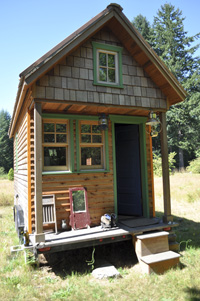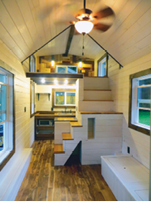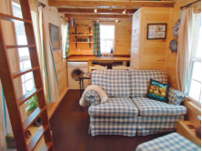How can CRSs serve the growing demand for smaller homes?
By Daniel Rome Levine
In the Los Angeles suburb of Yorba Linda, Betty Kerr is seeing bigger interest in smaller homes.
Its a trend Kerr, CRS, with Keller Williams Realty, first noticed about two years ago. She attributes it to peoples fears about their financial security in a shaky economy and a desire to reduce home-related expenses, especially utilities and maintenance.
My clients arent trying to keep up with the Joneses anymore, in terms of having the biggest house on the block, says Kerr.
When Kerr recently helped a family of six shop for a home, they started out thinking they wanted a property as big as 3,600 square feet, with five bedrooms and three bathrooms. After Kerr told them what their mortgage payments and utility bills were likely to be, they scaled back their search to houses closer to 2,000 square feet.
People are being more cautious and practical and really thinking things through, says Kerr. Its all about saving money in an economy where many people are scared of losing their jobs.

Why are tiny homes increasing in popularity? Tiny homes, like this mobile house in Olympia, Washington, come in a variety of shapes, sizes and designs, but what they have in common is a focus on smaller spaces and a simpler lifestyle. People are attracted to them for a variety of reasons, such as environmental and financial concerns, including the fact that many people spend a significant portion of their lifetime income on a larger home.
Sizes Trending Down
While the median size of new single-family homes built in 2013 hit an all-time high of 2,384 square feet, continuing an upward trend that started three years earlier, the trend in 2014 was one of declining median new-home sizes. Economists and housing experts attribute this recent contraction to the return of more first-time homebuyers to the market as credit constraints have loosened. First-time buyers typically purchase smaller homes.
The Residential Specialist reached out to a handful of CRSs around the country to size up the situation in their local markets. Their answers reveal rising interest in smaller homes, and the reasons behind the trend are as varied as the homes themselves.
Big Interest in Tiny Homes
In Munster, Indiana, Ed Riley, CRS, broker owner and president of Vail Realty Group, is seeing clients in their 30s and 40s asking about smaller homes that range from 1,400 to 1,800 square feet. The psychology is that a smaller house tends to lead to a more unified, tighter family, he says. People are also still nervous about the economy.
An even more significant trend Riley has noticed in his market over the last two years has been a spike in interest in so-called tiny homes, or properties that range in size from 100 to 400 square feet.

The interior of the Brevard Tiny House Company’s “Robin’s Nest” house in North Carolina.
Besides appealing to people who want simpler lifestyles and are seeking to reduce their environmental impact, these miniature homes are especially attractive to younger people who may be struggling financially. The homes are inexpensive, typically ranging from about $20,000 to $60,000, and they are highly mobile. Many are built on wheels and those that arent can easily be placed on a trailer and moved to a parents backyard, for instance. This also makes them ideal living spaces for elderly parents who want to be close to their grown children, says Riley, but who dont want to feel like a burden by living under the same roof.
Riley recently helped a couple purchase a 300-square-foot tiny home for about $35,000, which they placed in the backyard of their Lake Michigan beach cottage so their grown children would have an extra place to stay when they visit. Riley himself is even designing and building his own tiny home, which he plans on using as a mobile guest cottage and placing behind a summer property he owns.
A Social Movement
This isnt just a novelty, its a real social movement says Riley, The tiny house movement is picking up tremendous steam nationally. There is even a reality cable television series called Tiny House Nation that spotlights these homes and the people who live in them.
REALTORS® need to know about this movement, Riley says, if they want to set themselves apart and provide real value to clients who are looking for the simplicity and flexibility that tiny homes offer.

The interior of the Brevard Tiny House Company’s “Keep on the Sunny Side” house in North Carolina.
Bigger Is Not Always Better
When one thinks of the state of Texas, tiny is not a word that typically comes to mind. The slogan Everythings Bigger in Texas may be popular in the Lone Star state, but when it comes to real estate, size isnt as important as it used to be, says Bob Leonard, CRS, an associate broker with RE/MAX Associates in San Antonio.
For most of his nearly three decades selling real estate there, Leonard has seen home sizes steadily rise. Square footage was what is was all about, he says. People wanted the biggest house they could buy, and quality and construction was almost secondary.
More Info
You Think That’s Small?
Micro apartments one-room living spaces typically ranging in size from 250 to 375 square feet are popping up in urban centers across the country.
Thinking Small
After more than a decade building homes as big as 4,000 square feet, Andrew Pleban shrank his business in 2009 to focus on tiny homes.
But now, a growing number of aging baby boomers whose children have left the nest are downsizing to simplify their lives. Instead of size, they are looking for quality construction and high-end finishing details. Leonard is among them. There are a lot of us in the market who are moving down, he says. People are taking a step back and realizing they can do just as well with a smaller home with higher-quality finishes.
When his three children left the nest, Leonard moved from a sprawling four-bedroom, three-and-a-half bath, 3,300-square-foot McMansion, as he calls it, to a one-story, 2,300-square-foot home. Leonard says living on one floor is the most common way he sees people simplifying their lifestyles when they move into smaller homes. While I am perfectly capable of climbing stairs, I choose not to and I dont need to because there are no kids up there to yell at anymore to clean their rooms, he jokes.
Even though Leonards new home is smaller than his old one, it actually cost more because it is custom-built, is located in a more upscale neighborhood and has higher-quality touches throughout, such as terrazzo and hardwood floors and high-end crown molding. I traded size for quality and location, says Leonard, and that is what a lot of people my age are doing in this market.
Read more about the trend toward smaller homes at the National Association of Home Builders website.








